OpenAI is taking fresh steps to limit how its latest AI models might be used to spread dangerous information. With the release of its o3 and o4-mini models, the company has quietly introduced a new layer of protection aimed at catching and blocking prompts that deal with biological or chemical threats. This safety update is part of OpenAI’s wider effort to stay ahead of potential misuse as its AI grows more advanced.
While o3 and o4-mini offer a clear jump in reasoning capabilities compared to earlier models like o1 and even GPT-4, that improvement also raises the stakes. OpenAI admitted in a new safety report that o3, in particular, showed stronger performance when asked about how to create certain biological weapons. Though the company insists the models don’t cross their internal “high risk” threshold, it didn’t ignore the warning signs either.
To deal with this, OpenAI developed what it calls a “safety-focused reasoning monitor.” This monitor, custom-trained to understand the company’s content rules, actively screens user prompts to catch those involving bio or chemical threats. If it flags a risky query, it instructs the model not to respond.
How the New AI Monitor Works
The safety monitor doesn’t replace the AI—it sits on top of the o3 and o4-mini models. Its job is to spot dangerous inputs before the core model responds. It can identify sensitive prompts and act immediately, refusing to answer anything that could be used for harmful purposes.
OpenAI didn’t build this monitor overnight. To train the system, it had a group of red teamers spend about 1,000 hours trying to provoke unsafe responses from o3 and o4-mini. These red teamers documented examples of problematic conversations, which were then used to teach the system how to detect and stop similar attempts in real use.
The results, according to OpenAI, are promising. During simulated tests that mimicked the way the monitor would block dangerous prompts, the models refused to engage 98.7% of the time. That’s a strong rate, though not perfect—and OpenAI admits as much.
The company also acknowledged that these tests didn’t account for persistent users who might rephrase their prompts after a rejection. That’s why OpenAI is keeping human oversight in place, too. Automated monitoring can catch a lot, but it can’t replace human judgment completely—at least not yet.
Bio-Risk Awareness and Model Evolution
The decision to enhance safeguards with o3 and o4-mini highlights a broader concern: newer models are becoming increasingly good at answering complex and potentially dangerous questions. Even though o3 and o4-mini didn’t meet the criteria for “high risk,” OpenAI noted that they still showed significant improvements in fields like biosecurity-related reasoning—enough to raise red flags.
Compared to earlier models such as GPT-4, these newer systems are better at reasoning through step-by-step instructions. That’s great for most use cases, like research or education, but it also means the models might unintentionally offer guidance on topics like synthesizing harmful agents or weaponizing biological materials—topics that OpenAI wants to keep off-limits.
To prevent this, the company is taking a layered approach. The new monitor is just one part of its Preparedness Framework, a plan that outlines how OpenAI will detect and mitigate risks across all its AI products. The company says it is also actively evaluating whether its tools could assist in the development of chemical or biological weapons and updating safeguards accordingly.
Broader AI Safety Questions Remain
While OpenAI’s rollout of the new monitor shows progress, not everyone is convinced the company is doing enough. Critics argue that OpenAI should be more transparent, especially when it comes to how much red teaming and safety testing goes into its releases.
One example is the recent launch of GPT-4.1. Unlike earlier releases, OpenAI didn’t issue a dedicated safety report for this new model. This decision raised eyebrows among researchers, especially given the increased concerns about model misuse.
Even some of OpenAI’s own partners have voiced frustration. Metr, a group involved in red teaming o3, reported that it had limited time to run tests related to deceptive behavior. That lack of thorough evaluation makes it harder to know just how well the safeguards really work under pressure.
At the same time, OpenAI continues to expand the use of similar safety monitors beyond just text-based models. For instance, the company says it uses a related monitoring system to prevent its image-generating AI from producing illegal content, such as child sexual abuse material (CSAM). These reasoning monitors play a critical role in enforcing safety across all AI modalities.
Balancing Progress with Protection
The conversation around AI safety is only growing louder as models get more powerful. OpenAI’s latest actions suggest it’s trying to find a balance—allowing its tools to be helpful and widely used while staying vigilant about how they might be misused.
However, as AI evolves, so do the tactics of people who want to abuse it. No system, no matter how advanced, will ever be completely immune to misuse. The best OpenAI can do, it seems, is to keep updating its safeguards, testing for weaknesses, and staying transparent about what’s working and what isn’t.
In the case of o3 and o4-mini, OpenAI is being more proactive than it has been in the past. But whether that will be enough to earn public trust in the long run remains an open question.











